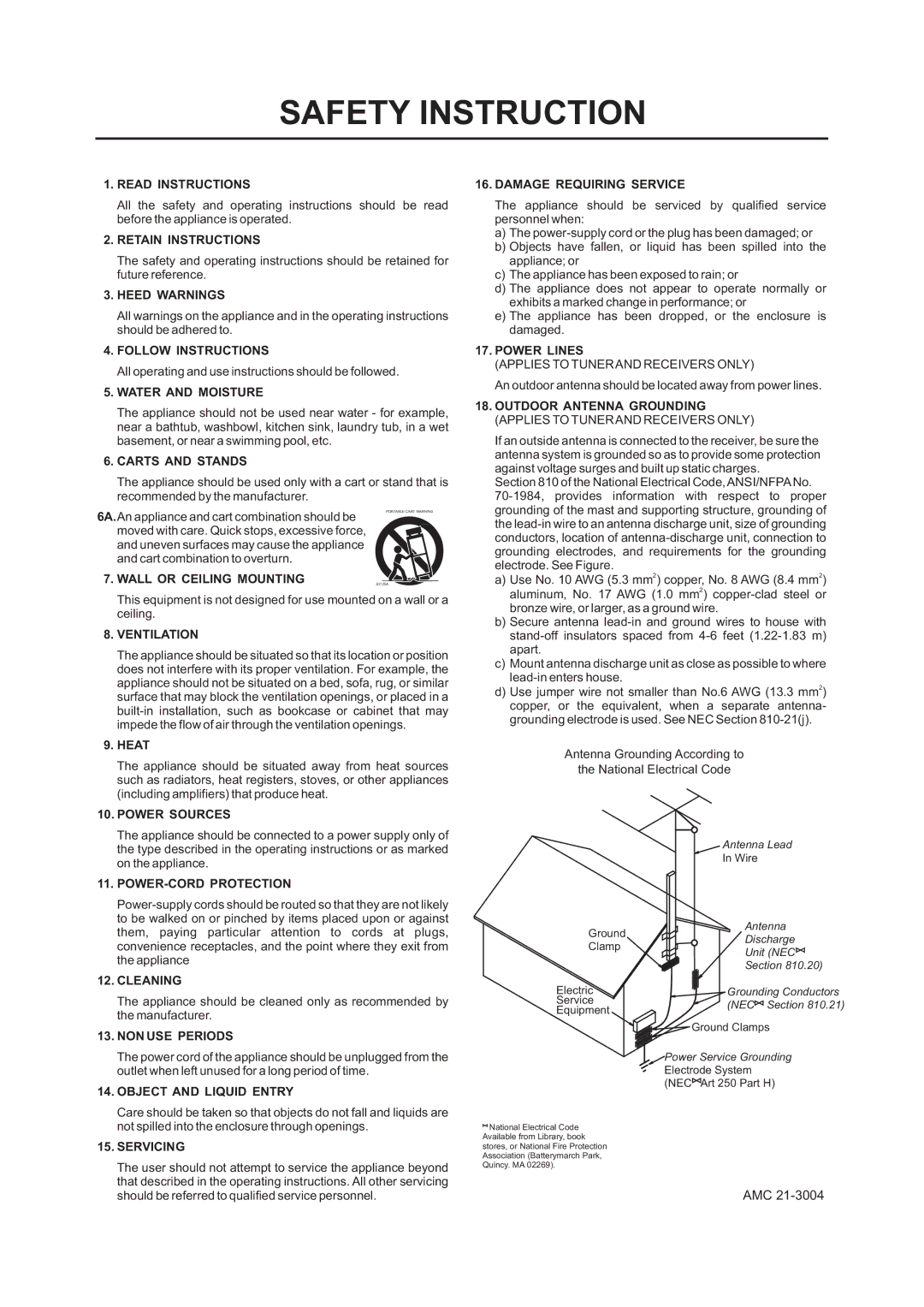
SAFETY INSTRUCTION
1.READ INSTRUCTIONS
All the safety and operating instructions should be read before the appliance is operated.
2.RETAIN INSTRUCTIONS
The safety and operating instructions should be retained for future reference.
3.HEED WARNINGS
All warnings on the appliance and in the operating instructions should be adhered to.
4.FOLLOW INSTRUCTIONS
All operating and use instructions should be followed.
5.WATER AND MOISTURE
The appliance should not be used near water - for example, near a bathtub, washbowl, kitchen sink, laundry tub, in a wet basement, or near a swimming pool, etc.
6.CARTS AND STANDS
The appliance should be used only with a cart or stand that is recommended by the manufacturer.
16. DAMAGE REQUIRING SERVICE |
The appliance should be serviced by qualified service |
personnel when: |
a) The |
b) Objects have fallen, or liquid has been spilled into the |
appliance; or |
c) The appliance has been exposed to rain; or |
d) The appliance does not appear to operate normally or |
exhibits a marked change in performance; or |
e) The appliance has been dropped, or the enclosure is |
damaged. |
17. POWER LINES |
(APPLIES TO TUNER AND RECEIVERS ONLY) |
An outdoor antenna should be located away from power lines. |
18. OUTDOOR ANTENNA GROUNDING |
(APPLIES TO TUNER AND RECEIVERS ONLY) |
If an outside antenna is connected to the receiver, be sure the |
antenna system is grounded so as to provide some protection |
against voltage surges and built up static charges. |
Section 810 of the National Electrical Code, ANSI/NFPA No. |
grounding of the mast and supporting structure, grounding of |
6A.An appliance and cart combination should be moved with care. Quick stops, excessive force, and uneven surfaces may cause the appliance and cart combination to overturn.
PORTABLE CART WARNING
the |
conductors, location of |
grounding electrodes, and requirements for the grounding |
electrode. See Figure. |
7. WALL OR CEILING MOUNTING
S3125A
This equipment is not designed for use mounted on a wall or a ceiling.
8.VENTILATION
The appliance should be situated so that its location or position does not interfere with its proper ventilation. For example, the appliance should not be situated on a bed, sofa, rug, or similar surface that may block the ventilation openings, or placed in a
9.HEAT
The appliance should be situated away from heat sources such as radiators, heat registers, stoves, or other appliances (including amplifiers) that produce heat.
10.POWER SOURCES
The appliance should be connected to a power supply only of the type described in the operating instructions or as marked on the appliance.
11.POWER-CORD PROTECTION
12.CLEANING
The appliance should be cleaned only as recommended by the manufacturer.
13.NON USE PERIODS
The power cord of the appliance should be unplugged from the outlet when left unused for a long period of time.
14.OBJECT AND LIQUID ENTRY
Care should be taken so that objects do not fall and liquids are not spilled into the enclosure through openings.
15.SERVICING
The user should not attempt to service the appliance beyond that described in the operating instructions. All other servicing should be referred to qualified service personnel.
a) Use No. 10 AWG (5.3 mm2) copper, No. 8 AWG (8.4 mm2) |
aluminum, No. 17 AWG (1.0 mm2) |
bronze wire, or larger, as a ground wire. |
b) Secure antenna |
apart. |
c) Mount antenna discharge unit as close as possible to where |
d) Use jumper wire not smaller than No.6 AWG (13.3 mm2) |
copper, or the equivalent, when a separate antenna- |
grounding electrode is used. See NEC Section |
Antenna Grounding According to
the National Electrical Code
| Antenna Lead | |
| In Wire | |
Ground | Antenna | |
Discharge | ||
Clamp | ||
Unit (NEC | ||
| ||
| Section 810.20) | |
Electric | Grounding Conductors | |
Service | (NEC Section 810.21) | |
Equipment | ||
| ||
| Ground Clamps |
Power Service Grounding
Electrode System
(NEC Art 250 Part H)
![]() National Electrical Code
National Electrical Code
Available from Library, book
stores, or National Fire Protection
Association (Batterymarch Park,
Quincy. MA 02269).
AMC
